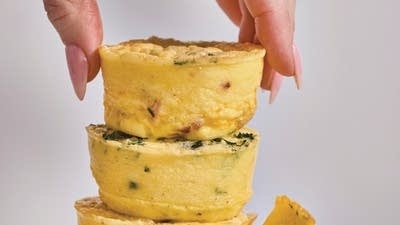
For this recipe you must put bay's association with stews and stocks out of your mind. The flavor of the fresh leaves is full of sweet spice. When I was dining at a small restaurant in Sussex, England, I had a wonderfully subtle bay leaf custard for dessert, and I learned there is a long history of bay being used to flavor sweet custards or rice pudding before vanilla was widely available. I like to use both. Fresh bay gives the custards a warm comforting flavor with hints of nutmeg and citrus and perfectly complements the crisp caramelized topping. Most important, it's subtle enough to be respectful of this classic dessert's simplicity.
Ingredients
2 cups whole milk, plus additional 2 tablespoons if needed, or substitute low-fat (2%) milk for a slightly less rich custard
2 cups heavy cream
12 fresh bay laurel leaves, cracked (not California bay or dried bay leaves)
1/2 vanilla bean, split and scraped, or 1 teaspoon vanilla extract
3 large eggs
5 large egg yolks
3/4 cup granulated sugar
1/8 teaspoon salt
About 1/4 cup turbinado sugar
Instructions
Molds: Arrange 8 6-ounce ramekins in a shallow baking pan large enough so that they don't touch.
Infuse the cream: Pour the milk and cream into a 2-quart saucepan and bring it to a boil over medium-high heat. Add the bay leaves and vanilla bean, if using, push them under the surface of the liquid with a spoon, and immediately remove the pan from the heat. Cover the pan and steep for 30 minutes. Strain the liquid through a fine sieve into a large liquid measuring cup, pressing down firmly on the herbs to extract all the liquid from the leaves. Add fresh milk if needed to measure 4 cups.
Custards: Preheat the oven to 325 degrees. In a medium mixing bowl, whisk together the eggs, egg yolks, granulated sugar, salt, and vanilla extract, if using, until smooth. Stir in the infused cream. Strain the custard through a fine sieve into a large pitcher or liquid measuring cup, then pour it into the ramekins, filling them almost to the top. Set the pan on the center oven rack and pour in enough hot tap water to come about 1/2 inch up the ramekins. Bake the custards until just set but still jiggly, 30 to 45 minutes. Don't let the custards bubble. The most crucial step is to pull them from the oven at just the right moment, but the baking time can vary greatly depending on the temperature of the custard when it was poured, so check them often. If your oven bakes unevenly, you might need to check each one individually. Refrigerate the custards until chilled, at least 2 hours.
Caramelized topping: Preheat your oven broiler to high with the oven rack 4 to 5 inches from the heat source. Just before serving, sprinkle the surface of the custards with a thin layer of turbinado sugar, using about 1/2 tablespoon for each. Shake the ramekins to even the sugar out. Broil the custards until the sugar caramelizes and turns a deep golden brown, but don't let them blacken. Crème brûlée means burnt cream but don't interpret the name literally.
Note: If you have a propane or butane torch, it will give you more control for caramelizing the topping. Hold the nozzle of the torch with a medium flame 2 to 3 inches from the top of each custard so that the tip of the flame touches the sugar and slowly move it in a circular motion until the sugar is evenly caramelized.
Adapted from The Herbfarm Cookbook by Jerry Traunfeld
Before you go...
Each week, The Splendid Table brings you stories that expand your world view, inspire you to try something new, and show how food connects us all. We rely on your generous support. For as little as $5 a month, you can have a lasting impact on The Splendid Table. And, when you donate, you’ll join a community of like-minded individuals who love good food, good conversation, and kitchen companionship. Show your love for The Splendid Table with a gift today.
Thank you for your support.
Donate today for as little as $5.00 a month. Your gift only takes a few minutes and has a lasting impact on The Splendid Table and you'll be welcomed into The Splendid Table Co-op.



